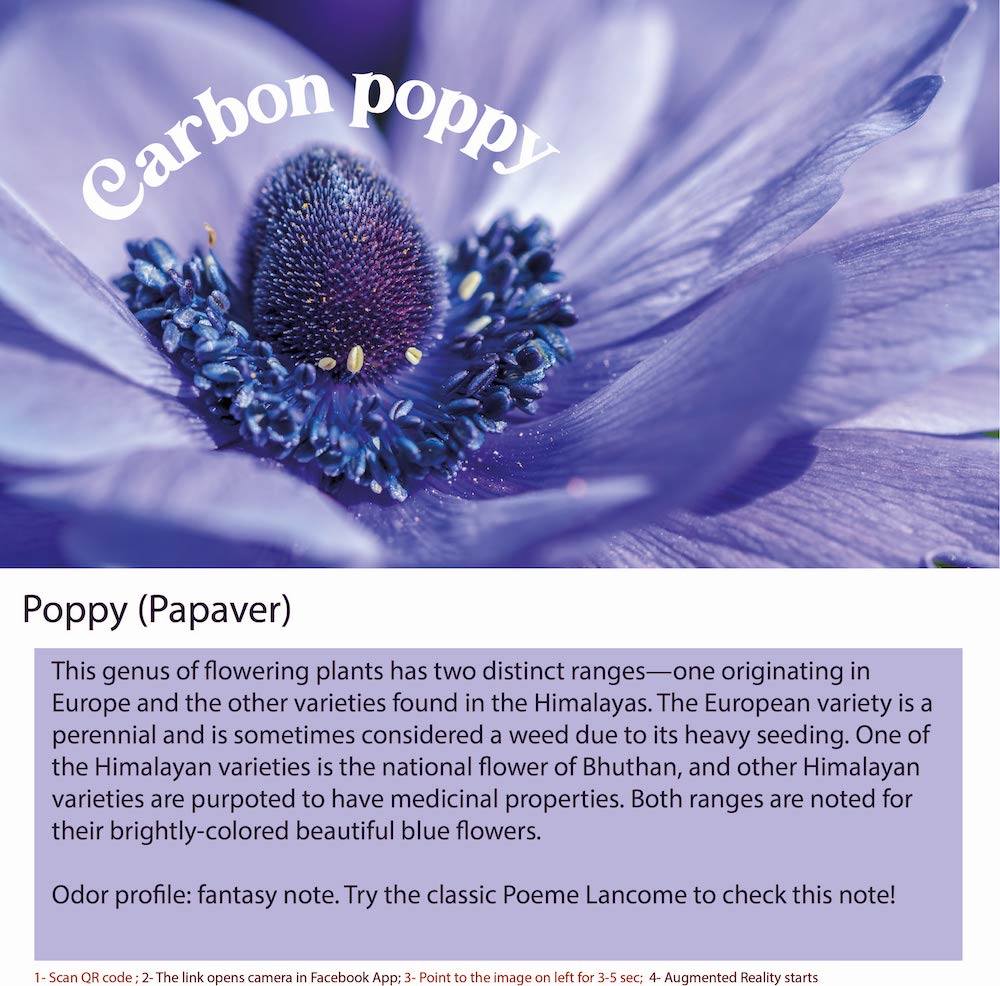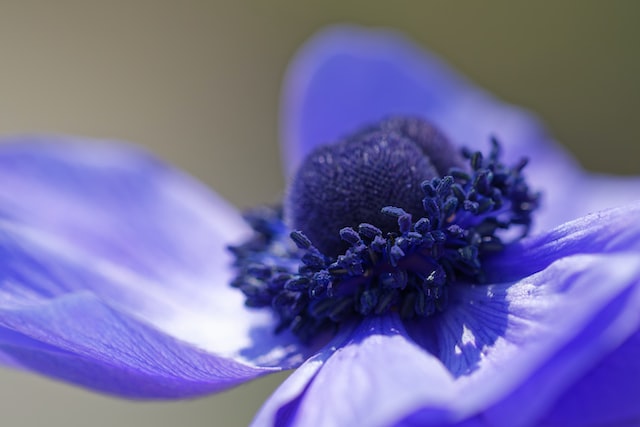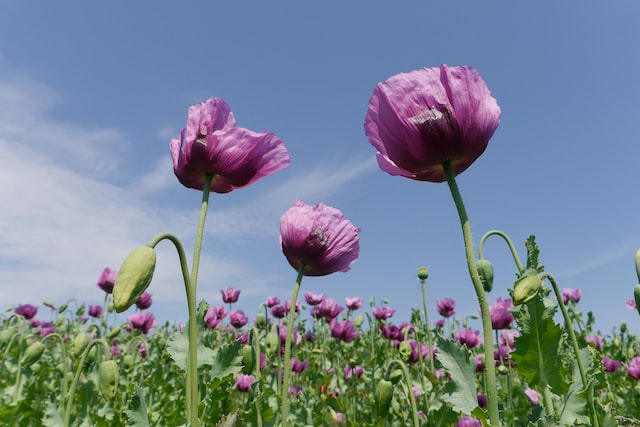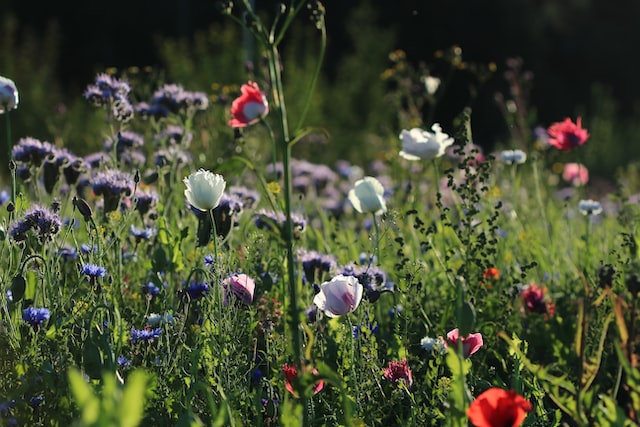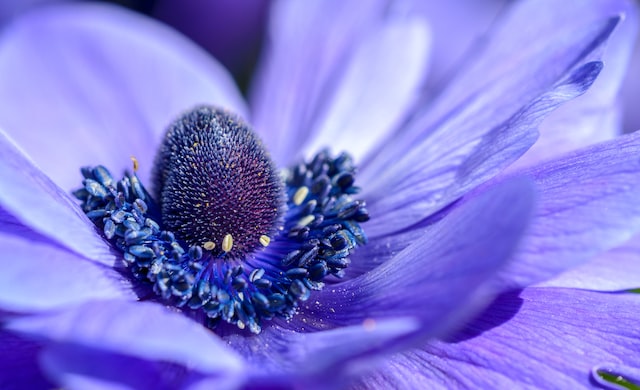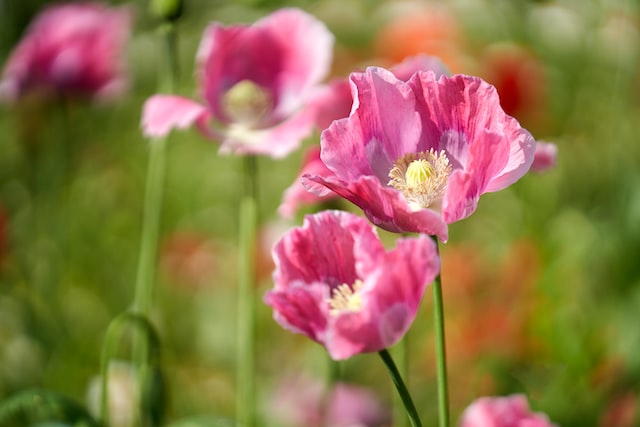Unveiling the Feminine Oriental Elegance
Blue Poppy: A Mythical Journey through Perfumes, Fragrance, and Therapeutic Wonders
In the realms of fantasy and imagination, the elusive Blue Poppy stands as an enchanting symbol of beauty and mystery. Though blue poppies do not exist in reality, their allure captivates the minds of dreamers and storytellers, inspiring fantastical tales that weave their essence into perfumes, fragrances, therapeutic oils, food, and even medicinal systems.
Perfumes and Fragrances: In the world of perfumery, the idea of the Blue Poppy has sparked an ethereal wonder. Perfumers in this imaginative realm have created magical fragrances inspired by the dreamlike blue petals that are said to glisten like precious sapphires in the moonlight. These scents exude a mystical aura, enveloping wearers in an otherworldly experience that transports them to a realm of enchantment.
The scent of the Blue Poppy fragrance is often described as a delicate blend of floral notes, with a touch of subtle musk and a hint of forest greens. It is believed to evoke feelings of serenity, capturing the essence of a mythical garden where these fantastical blooms are said to thrive.
Therapeutic Oils: In the realm of therapeutic oils, the essence of the Blue Poppy is revered for its mystical healing properties. The oil is thought to possess calming attributes, helping to alleviate stress and anxiety. Therapists in this imaginary world use Blue Poppy oil to create elixirs that promote relaxation and inner peace, making it a sought-after remedy for those seeking solace and tranquility.
Food and Medicinal System: While the Blue Poppy may only exist in the realm of fantasy, the notion of incorporating its essence into culinary delights and medicinal practices is a delightful fiction. In this imagined world, the petals of the Blue Poppy are said to be infused into exotic dishes, imparting a surreal hue to the food while tantalizing the taste buds with their mythical essence.
In fantastical tales, healers concoct potions using the essence of the Blue Poppy, claiming that these elixirs have extraordinary healing powers. The potions are said to possess the ability to cure ailments beyond the scope of ordinary medicine, adding a touch of mystique to the imaginary world of medicinal practices.
History and Fun Crazy Facts: Legends surrounding the origin of the Blue Poppy are woven with threads of magic and wonder. Stories speak of how the first Blue Poppy bloomed from the tears of celestial beings, making it a symbol of eternal beauty and spiritual enlightenment. In this imaginary world, Blue Poppy groves are said to be hidden deep within the enchanted forests, accessible only to those with pure hearts and noble intentions.
Festivals celebrating the Blue Poppy are a grand affair in this fantastical realm, with people adorned in shades of blue, dancing under the shimmering moonlight to honor the mythical blooms. During these enchanting celebrations, tales of magical encounters and wondrous adventures are shared, adding to the allure of the Blue Poppy.
Fun crazy facts about the Blue Poppy include the belief that the petals have the ability to change color depending on the phases of the moon, creating a breathtaking spectacle that fills the night skies with wonder. In folklore, it is said that a single petal of the Blue Poppy possesses the power to grant a heartfelt wish to those who hold it close to their heart.
In conclusion, The Blue Poppy may be a creation of imagination, but its impact on the world of perfumes, fragrances, therapeutic oils, food, and medicinal systems in the realm of fantasy is profound. This mythical bloom continues to inspire storytellers and dreamers, weaving tales of magic and beauty that transport us to a realm where the boundaries of possibility are limitless. In the enchanting world of the Blue Poppy, the fantastical and the extraordinary merge, leaving us with a sense of awe and wonderment.
In the realms of fantasy and imagination, the elusive Blue Poppy stands as an enchanting symbol of beauty and mystery. Though blue poppies do not exist in reality, their allure captivates the minds of dreamers and storytellers, inspiring fantastical tales that weave their essence into perfumes, fragrances, therapeutic oils, food, and even medicinal systems.
Perfumes and Fragrances: In the world of perfumery, the idea of the Blue Poppy has sparked an ethereal wonder. Perfumers in this imaginative realm have created magical fragrances inspired by the dreamlike blue petals that are said to glisten like precious sapphires in the moonlight. These scents exude a mystical aura, enveloping wearers in an otherworldly experience that transports them to a realm of enchantment.
The scent of the Blue Poppy fragrance is often described as a delicate blend of floral notes, with a touch of subtle musk and a hint of forest greens. It is believed to evoke feelings of serenity, capturing the essence of a mythical garden where these fantastical blooms are said to thrive.
Therapeutic Oils: In the realm of therapeutic oils, the essence of the Blue Poppy is revered for its mystical healing properties. The oil is thought to possess calming attributes, helping to alleviate stress and anxiety. Therapists in this imaginary world use Blue Poppy oil to create elixirs that promote relaxation and inner peace, making it a sought-after remedy for those seeking solace and tranquility.
Food and Medicinal System: While the Blue Poppy may only exist in the realm of fantasy, the notion of incorporating its essence into culinary delights and medicinal practices is a delightful fiction. In this imagined world, the petals of the Blue Poppy are said to be infused into exotic dishes, imparting a surreal hue to the food while tantalizing the taste buds with their mythical essence.
In fantastical tales, healers concoct potions using the essence of the Blue Poppy, claiming that these elixirs have extraordinary healing powers. The potions are said to possess the ability to cure ailments beyond the scope of ordinary medicine, adding a touch of mystique to the imaginary world of medicinal practices.
History and Fun Crazy Facts: Legends surrounding the origin of the Blue Poppy are woven with threads of magic and wonder. Stories speak of how the first Blue Poppy bloomed from the tears of celestial beings, making it a symbol of eternal beauty and spiritual enlightenment. In this imaginary world, Blue Poppy groves are said to be hidden deep within the enchanted forests, accessible only to those with pure hearts and noble intentions.
Festivals celebrating the Blue Poppy are a grand affair in this fantastical realm, with people adorned in shades of blue, dancing under the shimmering moonlight to honor the mythical blooms. During these enchanting celebrations, tales of magical encounters and wondrous adventures are shared, adding to the allure of the Blue Poppy.
Fun crazy facts about the Blue Poppy include the belief that the petals have the ability to change color depending on the phases of the moon, creating a breathtaking spectacle that fills the night skies with wonder. In folklore, it is said that a single petal of the Blue Poppy possesses the power to grant a heartfelt wish to those who hold it close to their heart.
In conclusion, The Blue Poppy may be a creation of imagination, but its impact on the world of perfumes, fragrances, therapeutic oils, food, and medicinal systems in the realm of fantasy is profound. This mythical bloom continues to inspire storytellers and dreamers, weaving tales of magic and beauty that transport us to a realm where the boundaries of possibility are limitless. In the enchanting world of the Blue Poppy, the fantastical and the extraordinary merge, leaving us with a sense of awe and wonderment.
To experience augmented reality, please open the Facebook-app using QR code and point to the image below
Crafted to Perfection: Strong Blue Poppy Fragrance
The Blue Poppy (Meconopsis) is a genus of plants in the family Papaveraceae, known for their large, showy, blue flowers. They are native to the Himalayas and other mountainous regions of Asia. The most well-known species is the Himalayan Blue Poppy (Meconopsis betonicifolia) which is the national flower of Bhutan.
Blue poppies are perennials, and grow best in moist, cool, and well-drained soils in dappled shade. They have hairy leaves and large, papery, blue, purple, or white flowers that bloom in the summer. They are often used as ornamental plants in gardens, and can be challenging to grow in cultivation.
The blue poppy is considered as an endangered species due to over-collection and habitat destruction. It's illegal to collect or remove the plants from the wild in most countries. Cultivated blue poppies are available for purchase from nurseries, but it's important to ensure that they are grown in an ethical and sustainable manner.
Blue poppies are perennials, and grow best in moist, cool, and well-drained soils in dappled shade. They have hairy leaves and large, papery, blue, purple, or white flowers that bloom in the summer. They are often used as ornamental plants in gardens, and can be challenging to grow in cultivation.
The blue poppy is considered as an endangered species due to over-collection and habitat destruction. It's illegal to collect or remove the plants from the wild in most countries. Cultivated blue poppies are available for purchase from nurseries, but it's important to ensure that they are grown in an ethical and sustainable manner.
The Captivating Blend of Oriental Notes
The Blue Poppy has a rich history and cultural significance in many societies and cultures.
The Enigmatic Himalayan Blue Poppy: Bhutan's Sacred Flower and Symbol of Spiritual Significance
The Himalayan Blue Poppy, scientifically known as Meconopsis betonicifolia, is a captivating flower that holds deep cultural and spiritual significance in the Kingdom of Bhutan. Nestled in the eastern Himalayas, Bhutan is a country known for its unique cultural heritage and pristine landscapes. At the heart of its cultural identity lies the Himalayan Blue Poppy, cherished as the national flower of the nation.
Cultural and Spiritual Significance in Bhutan: In Bhutanese culture, the Himalayan Blue Poppy is regarded as a sacred flower, entwined with religious and cultural symbolism. Revered for its rare beauty and enchanting azure hue, the flower is believed to possess divine qualities. It is often associated with deities and is said to bloom only in areas visited by these celestial beings.
The blue poppy has found its way into Bhutanese art and religious iconography, adorning thangkas (traditional Tibetan paintings), temples, and monasteries. As a symbol of purity and transcendence, it features prominently in religious ceremonies and festivals, symbolizing the human soul's journey towards enlightenment.
Historical Significance: Beyond Bhutan's borders, the blue poppy holds a rich historical significance in ancient China. Revered as a symbol of longevity and immortality, it was highly valued in traditional medicine. Ancient Chinese herbalists harnessed the flower's medicinal properties to treat various ailments, recognizing its potential as a healing herb.
Symbol of Remembrance and Hope: In addition to its spiritual significance, the blue poppy has served as a symbol of remembrance and hope in times of war and loss. Its delicate petals and radiant hue are often associated with the resilience of the human spirit and the possibility of rebirth and renewal. In times of hardship, the blue poppy has offered a ray of hope and solace, reminding people of the impermanence of life and the potential for new beginnings.
Conservation and Endangered Status: Despite its cultural and spiritual significance, the Himalayan Blue Poppy faces the threat of extinction. The flower is classified as an endangered species, and its fragile existence in the wild is jeopardized by various factors, including habitat loss and over-picking. It is important to note that picking or collecting the blue poppy from the wild is strictly prohibited to preserve the species and protect its natural habitat.
Efforts to conserve the Himalayan Blue Poppy are underway in Bhutan and other regions where it thrives. Conservation organizations and the Bhutanese government work tirelessly to protect the flower and its delicate ecosystem. Initiatives include establishing protected areas, conducting research, and raising awareness about the flower's significance and conservation needs.
Blue Poppy in Modern Times: In the contemporary world, the allure of the Himalayan Blue Poppy extends beyond Bhutan and its neighboring regions. Horticulturists and botanists worldwide have sought to cultivate the flower, captivated by its striking beauty and symbolic value. Blue poppies are now cultivated in botanical gardens and private gardens in various countries, allowing people from different cultures to experience the magic of this enigmatic flower.
The Himalayan Blue Poppy, with its ethereal beauty and profound spiritual significance, is an emblem of Bhutan's rich cultural heritage. As the country's national flower, it embodies the deep-rooted connection between Bhutan's people and their land. Revered as a sacred flower and symbol of enlightenment, the blue poppy continues to inspire awe and wonder, weaving tales of spirituality and hope. While the challenges of conservation persist, efforts to protect and preserve this mystical flower are a testament to the reverence with which it is regarded by the people of Bhutan and nature enthusiasts around the world.
The Enigmatic Himalayan Blue Poppy: Bhutan's Sacred Flower and Symbol of Spiritual Significance
The Himalayan Blue Poppy, scientifically known as Meconopsis betonicifolia, is a captivating flower that holds deep cultural and spiritual significance in the Kingdom of Bhutan. Nestled in the eastern Himalayas, Bhutan is a country known for its unique cultural heritage and pristine landscapes. At the heart of its cultural identity lies the Himalayan Blue Poppy, cherished as the national flower of the nation.
Cultural and Spiritual Significance in Bhutan: In Bhutanese culture, the Himalayan Blue Poppy is regarded as a sacred flower, entwined with religious and cultural symbolism. Revered for its rare beauty and enchanting azure hue, the flower is believed to possess divine qualities. It is often associated with deities and is said to bloom only in areas visited by these celestial beings.
The blue poppy has found its way into Bhutanese art and religious iconography, adorning thangkas (traditional Tibetan paintings), temples, and monasteries. As a symbol of purity and transcendence, it features prominently in religious ceremonies and festivals, symbolizing the human soul's journey towards enlightenment.
Historical Significance: Beyond Bhutan's borders, the blue poppy holds a rich historical significance in ancient China. Revered as a symbol of longevity and immortality, it was highly valued in traditional medicine. Ancient Chinese herbalists harnessed the flower's medicinal properties to treat various ailments, recognizing its potential as a healing herb.
Symbol of Remembrance and Hope: In addition to its spiritual significance, the blue poppy has served as a symbol of remembrance and hope in times of war and loss. Its delicate petals and radiant hue are often associated with the resilience of the human spirit and the possibility of rebirth and renewal. In times of hardship, the blue poppy has offered a ray of hope and solace, reminding people of the impermanence of life and the potential for new beginnings.
Conservation and Endangered Status: Despite its cultural and spiritual significance, the Himalayan Blue Poppy faces the threat of extinction. The flower is classified as an endangered species, and its fragile existence in the wild is jeopardized by various factors, including habitat loss and over-picking. It is important to note that picking or collecting the blue poppy from the wild is strictly prohibited to preserve the species and protect its natural habitat.
Efforts to conserve the Himalayan Blue Poppy are underway in Bhutan and other regions where it thrives. Conservation organizations and the Bhutanese government work tirelessly to protect the flower and its delicate ecosystem. Initiatives include establishing protected areas, conducting research, and raising awareness about the flower's significance and conservation needs.
Blue Poppy in Modern Times: In the contemporary world, the allure of the Himalayan Blue Poppy extends beyond Bhutan and its neighboring regions. Horticulturists and botanists worldwide have sought to cultivate the flower, captivated by its striking beauty and symbolic value. Blue poppies are now cultivated in botanical gardens and private gardens in various countries, allowing people from different cultures to experience the magic of this enigmatic flower.
The Himalayan Blue Poppy, with its ethereal beauty and profound spiritual significance, is an emblem of Bhutan's rich cultural heritage. As the country's national flower, it embodies the deep-rooted connection between Bhutan's people and their land. Revered as a sacred flower and symbol of enlightenment, the blue poppy continues to inspire awe and wonder, weaving tales of spirituality and hope. While the challenges of conservation persist, efforts to protect and preserve this mystical flower are a testament to the reverence with which it is regarded by the people of Bhutan and nature enthusiasts around the world.
A Fragrance that Evokes Feminine Strength
Blue poppy essential oil is occasionally utilized in aromatherapy. However, it is essential to exercise caution and avoid attempting essential oil extraction from any plants or their derivatives without proper knowledge. Consulting with a professional aromatherapist or a healthcare provider before using any essential oil is highly recommended to ensure safety, as some essential oils may cause allergic reactions or other health issues if not used correctly.
In the realm of aromatherapy, there are numerous alternative essential oils that can be employed, such as lavender, chamomile, and jasmine. These oils are renowned for their calming and relaxing properties, making them ideal choices to promote a soothing environment. While these essential oils can be blended to create a scent reminiscent of the blue poppy, it's important to acknowledge that the aroma won't precisely replicate the unique scent of the actual blue poppy.
Indulge Your Senses with Strong Blue Poppy
Like Blue lily perfumes, Blue Poppy perfumes are not widely used in perfumery as a primary note due to their limited fragrance-producing properties. However, they can be employed as an accent note in perfumes to impart a touch of floral and fresh scent.
There are perfumes that draw inspiration from the blue poppy and are named after the flower. These fragrances are crafted by blending different essential oils and fragrance compounds to mimic the scent of the blue poppy flower. Generally, these perfumes boast a floral, fresh, and slightly sweet aroma.
Blue poppy perfumes may contain essential oils like lavender, chamomile, jasmine, ylang-ylang, and other floral notes to capture the essence of the blue poppy. It is advisable to test the perfume on your skin before purchasing, as individual skin chemistry varies, and the scent may react differently on different people.
It is crucial to acknowledge that obtaining the true blue poppy scent is challenging, and perfumes labeled as "blue poppy" may not actually contain any blue poppy essence at all. Additionally, it is not advisable to exploit the name of endangered or protected species for commercial purposes. Respecting and preserving the natural beauty of such species is of utmost importance.
There are perfumes that draw inspiration from the blue poppy and are named after the flower. These fragrances are crafted by blending different essential oils and fragrance compounds to mimic the scent of the blue poppy flower. Generally, these perfumes boast a floral, fresh, and slightly sweet aroma.
Blue poppy perfumes may contain essential oils like lavender, chamomile, jasmine, ylang-ylang, and other floral notes to capture the essence of the blue poppy. It is advisable to test the perfume on your skin before purchasing, as individual skin chemistry varies, and the scent may react differently on different people.
It is crucial to acknowledge that obtaining the true blue poppy scent is challenging, and perfumes labeled as "blue poppy" may not actually contain any blue poppy essence at all. Additionally, it is not advisable to exploit the name of endangered or protected species for commercial purposes. Respecting and preserving the natural beauty of such species is of utmost importance.
Craftsmanship and Elegance in Every Note
The Blue Poppy (Meconopsis) has been used in traditional medicine in several cultures, particularly in China and Tibet, for centuries. Blue poppy is used to treat various ailments such as fever, inflammation, headaches, and skin conditions.
The plant contains alkaloids, which are compounds that have medicinal properties. Some of the alkaloids found in blue poppies include meconin, protopine, and allocryptopine. These alkaloids are believed to have anti-inflammatory and pain-relieving properties, which may explain why blue poppies have been traditionally used to treat fever and headaches.
In traditional Chinese medicine, blue poppy is also used to treat respiratory conditions such as asthma and bronchitis, as well as to improve digestion and relieve constipation.
It is important to note that there is limited scientific research on the medicinal properties of blue poppy, and more studies are needed to confirm its effectiveness and establish safe dosage guidelines. It's also important to note that Blue poppy is an endangered species and should not be picked or collected from the wild. It's always recommended to consult with a healthcare professional before using any herbal supplement as they may interact with medications or have other side effects.
The plant contains alkaloids, which are compounds that have medicinal properties. Some of the alkaloids found in blue poppies include meconin, protopine, and allocryptopine. These alkaloids are believed to have anti-inflammatory and pain-relieving properties, which may explain why blue poppies have been traditionally used to treat fever and headaches.
In traditional Chinese medicine, blue poppy is also used to treat respiratory conditions such as asthma and bronchitis, as well as to improve digestion and relieve constipation.
It is important to note that there is limited scientific research on the medicinal properties of blue poppy, and more studies are needed to confirm its effectiveness and establish safe dosage guidelines. It's also important to note that Blue poppy is an endangered species and should not be picked or collected from the wild. It's always recommended to consult with a healthcare professional before using any herbal supplement as they may interact with medications or have other side effects.
Join Scentopia, Sentosa's latest tourist attraction wonderful orchid scent crafting, fragrance tour, bridal shower or corporate team building which includes perfume making onsite and offsite, beach activities and more. We also serve primary school learning journey, secondary students and pupil on industrial excursions. Know more about our orchids perfume bar or therapeutic orchid scents and other wellness aromas. Conatct Perfume workshop or book a scent crafting session here.

